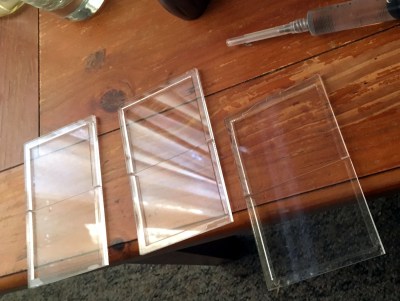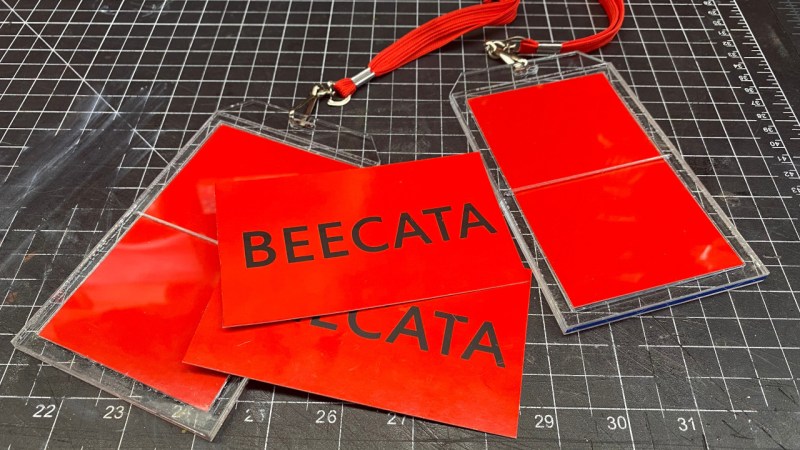Here at Hackaday, we pride ourselves on bringing you the latest and greatest projects for your viewing pleasure. But sometimes we come across a creation so interesting that we find ourselves compelled to write about it, even if it’s already been hanging around the Internet for years. This may or may not be due to the fact that we just re-watched Crimson Tide, and found ourselves on a self-imposed dive into a very particular rabbit hole…
If you’ve seen Crimson Tide, or the first few minutes of WarGames, you might already know what this post is about. Both films prominently make use of a one-time authentication device which the user snaps in half to reveal a card that has some secret code printed on it — and as it turns out, there are at least two different projects that aim to replicate the props used in the movies.
 The props were inspired by the real-world “Sealed Authenticators” used by the United States to verify commands regarding the launch of nuclear weapons. As shown in the films, once a launch order, known as an Emergency Action Message, is received, its validity could be confirmed by breaking open one of the Authenticators and comparing the code sequence printed on it to what was sent along with the message. Supposedly the real ones are more like foil envelopes that would be torn open, but presumably that wasn’t cool enough for Hollywood.
The props were inspired by the real-world “Sealed Authenticators” used by the United States to verify commands regarding the launch of nuclear weapons. As shown in the films, once a launch order, known as an Emergency Action Message, is received, its validity could be confirmed by breaking open one of the Authenticators and comparing the code sequence printed on it to what was sent along with the message. Supposedly the real ones are more like foil envelopes that would be torn open, but presumably that wasn’t cool enough for Hollywood.
So how do you make your own film-quality Authenticator? The two projects take slightly different approaches, but the basic idea is to create a three layer acrylic stack. The top and bottom pieces are identical, and scored in the middle so they’ll break along a clean line. The center piece is cut in half and largely hollowed out to create the compartment for your printed message. It’s perhaps best described as two “C” shapes that have slight gap where they meet, which provides some room for the top and bottom layers to flex. With the acrylic pieces aligned and the message inside, everything is solvent welded together.
Of course, the question now is what to do with them. We can think of all sorts of games and challenges that could make use of this kind of thing, but if you’re looking for something a little more practical, these would be an awesome way to store your two-factor authentication recovery codes. With the proper software, you could even use these for secure file storage via QR code.
















May the next thing you find joy in be crushed by a steam roller
Please seek professional help if you incite violence. He could find joy in his cat, dog or family. Now what?
lighten up
Good way to work the kinks out of one’s back.
Before relying on that, you might want to meditate on some of these people’s images:
https://www.lumafield.com/blog
and before someone interjects “why would anyone xray that?!??”
scalpers are literally CT scanning pokemon card packs for rare foil cards.
I wonder if there’s a detectable weight difference between the foil-card-containing packs and the ones without..
there used to be. in the late 90’s you’d have the scalpers come into target ultra early on a shipment day with their pocket drug scales, weighing cards till they were kicked out.
Couldn’t you just wrap in alum foil to prevent this?
Bigger fish to fry than this DIY, focus elsewhere.
“Artistic License”. Oh Yeah, I’m guilty of liking a cool gimmick in a movie also.
I was also guilty of straight to thinking of the scanning/X-ray stuff like Sok Puppette mentioned above.
Just gotta ask yourself, Do ya want a documentary or a couple hours of escapism in a new Mission Impossible or Jason Statham style flick?
No complaints if we get a bit education also though. Just remember though, the use of a burning bar/rod in the movie “Thief” (1981) drew a bit unhappy noise in its day.
Sometimes I just want a night of slightly toasty voice coils in my woofers and a break from the six-o-clock news.
An oxygen lance?
They exist and are very cool.
Another good reason to home brew some LOX.
Homemade LOX:
Get tank of Liquid nitrogen.
Make sheet metal cone and attach to hardware to screw onto tank outlet, angled downward.
Set old school, glass inside, thermos under low point of cone edge.
Open nitrogen tank valve, there will be some noise.
Don’t asphyxiate or die from runaway tank.
Liquid air will collect on outside of cone and drip into thermos.
When thermos full/tank empty, put thermos in bottom of, cold as possible, deep freeze.
Wait two weeks.
What’s left in thermos is almost pure LOX.
Beware feds and others in anti-fun brigade, don’t get caught.
Always someone with an interesting input, around here! ..it’s why I keep reading.
If the staff ever cracks down on the puns I’ll be heartbroken.
As for the burning lance (couldn’t recall the proper name earlier) When the “Thief” movie came out, there was a bit of complaint that the use of the lance was too educational for the general populace and any budding criminals.